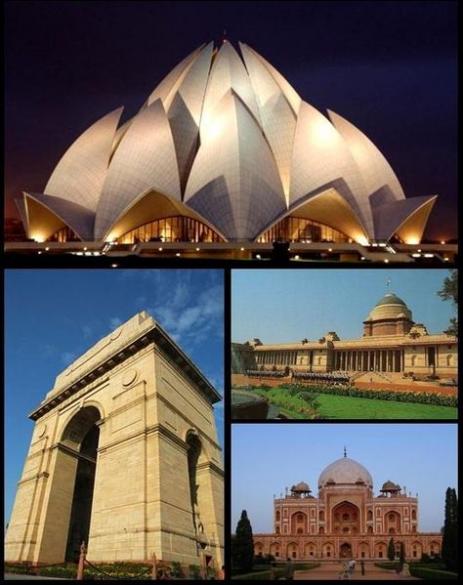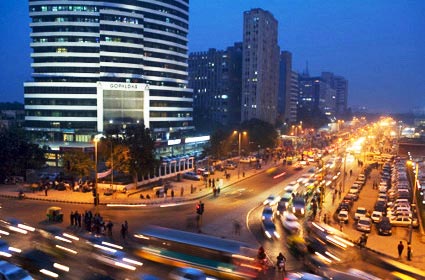

Delhi has a population of approximately 17 million people. That’s
such a large number that one needs to think about it to put it into some kind of perspective. It’s four times the population of Ireland, for example, and greater
than the population of the entire human race until about 2000 BC. In other words, at any time before 4,000 years ago, every human being on the face of the earth
would be less than the number of people who currently call Delhi home.
Initially, it feels as though about one in ten Delhites’ primary occupation is the business of trying to rip off hapless tourists. Admittedly, we were
staying right smack in the middle of Delhi, in Connaught Square. Touts flock there, scenting tourist honey. As there are not nearly enough tourists to satisfy
the rapacious needs of such a large number of would-be tricksters, especially off-season during the monsoon, fierce competition has created a race of super touts
and conmen, who could easily win Olympic gold medals in hustling, if such an event existed.
The Con
I have travelled more than a little in my time, and I’ve come across
some pretty clever conmen, but these were mere beginners in comparison with even the most mediocre of Delhi touts. They are a breed apart.
It starts a soon as you leave your hotel, when friendly strangers
approach you with helpful advice. The golden rule is that anyone who appears to want to help you actually wants to rip you off in one way or another: taxi drivers want to charge you double or triple what they would charge an Indian; all want to bring you into a travel agent’s and thereby collect a
kickback on anything you purchase; everyone wants to show you the "best" hotels, shops and restaurants, focused on the commission they will receive from you being overcharged; everyone is keen to strike up a conversation, find out where you are from, build up a relationship, and then proffer
some ‘independent’ advice, which if taken, is going to cost you, one way or another.
Being a mistrustful misanthrope from birth, my cynicism kept me out of their clutches at first. However, as it’s 40 degrees in Delhi in
August and monsoon season, I could not avoid all human contact, as much as I tried to.
The first time I was ripped off was in an auto rickshaw, or tuk-tuk as they are called in Thailand; a curious three-wheeled contraption,
which is basically a motorbike with a bit of cart stuck on the back. It’s cheaper than a taxi and can often move faster through heavy traffic due to its diminutive
size. It also allows you to appreciate the appalling pollution of Delhi more thoroughly, as there’s nothing to prevent the exhaust fumes of other vehicles going
right into your lungs and sticking to your clothes and skin.
The excitement of being that much closer to death also adds something to the ride, as in the event of a crash with a car, it offers you about as much protection
as a cornflakes box. I don’t know why, but I’ve always loved these vehicles. Ever since Thailand I’ve used them whenever possible, even though I know they
are dangerously unsafe.
For our first Delhi tuk-tuk ride, we wanted to go to the National Museum. My Lonely Planet
guidebook informed me that the price was 20 rupees, or 33 cents. Needless to say, I had to pay triple that, and constantly refuse my driver’s earnest entreaties to hire him as my driver for the day, or week, or month, and if I had wanted to hire him for the rest of his
natural life, a special discount would no doubt have been forthcoming. His main argument was that I could trust him because he had told me that his metre was rigged,
and that his honesty in admitting this to me was evidence that he was a man I could trust.
The logic of the argument escaped me, but I have been raised in the
traditional western rationalist mode of thinking; the subtleties of Indian thought often elude me. I was also surprised to find that he didn’t have any change. These guys never seemed to have any change,
which struck me as odd, as surely their profession demands it. Not only tuk-tuk drivers, but a vast array of people working in various service industries seem
to be permanently bereft of change – curiously enough though, only when dealing with foreigners. I sympathised with the embarrassment they must feel in constantly
having to pocket the change from large bills. They must be wracked by guilt.
National Museum
I found the National Museum rather dull. While it was clearly a treasure trove of archaeological relics from ancient Indus valley kingdoms, I never really could summon up much interest in bits of old broken pottery. I’m not remotely interested in new pottery either, to be honest. Bowls and plates are just things I eat from, and wash up afterwards; I never give them a second thought, heartless cad that I am.
There were some interesting exhibits regarding the early Harappan civilisations, a culture I had never even heard of. At its height, between 2600 and 1900 BC, it rivalled the ancient Assyrian, Babylonian and even Chinese empires. It was particularly advanced in urban planning. Recent excavations of Harappan cities have shown advanced drainage and sewer systems, far more advanced than contemporary towns in the Middle East and China, which struck me as ironic, considering how many Indians lack access to basic sanitation today, four thousand years later.
Harappa, the first of the forgotten Harappan cities to be excavated, which amazingly lay undiscovered and unknown until 1921, also showed a marked segregation of society. One part was probably for priests and administrators only; another part for the plebeian lower castes. On the other hand, all city dwellers had access to clean water and sewage systems. House sizes seemed not to differ enormously, so perhaps there was an egalitarianism that is so markedly
absent from modern India.There are so many unknowns about
Harappan culture that it’s hard to draw any conclusions. Most mysteriously, the Harappan cities were abandoned and forgotten for reasons unknown about
1700 BC. Climatic change has been put forward as the most probable reason, but no one really knows.
The museum also contained innumerable statues of strange Hindu gods. You know the kind: half man, half
bird; half man, half elephant; elephant/bird/man with six arms and a trunk. There are over 330,000 supernatural beings in Hinduism, the world’s oldest and
third-largest religion, but I can’t believe any of the one billion adherents of Hinduism actually know all of these mini-gods. The dusty statues,
divorced from their original context, didn’t excite my interest.
Perhaps what the museum really lacked, at least for me, was information beside each exhibit telling ignorant foreigners like myself what
I was actually looking at, and what it all meant.
I remember feeling a similar sense of disappointment at the Cairo National Museum, and wished, without meaning
to sound "colonial", that both the Delhi and the Cairo museum were more like the British Museum in London. Needless to say, I kept this insight from
the museum curators, not wanting to be accused of cultural imperialism, which I must admit, would be a fair accusation in this case. Not for the first time, I
criticised what I did not understand.
Back in the baking street, accosted by beggars with babies on one side, and tuk tuk drivers kerb crawling us on the other, we took refuge in the Meridian, ate an overpriced buffet meal quickly because the buffet was about to close.
I wondered why they hadn’t told us this before seating us,
since our main objective was to escape the heat for a while, not to eat a very expensive meal fast. We tried to relax in the bar afterwards, but we were
refused entry, as the bar was strictly for hotel residents, not for the likes of us. They told us in such a way as to let us know that they knew that we really
didn’t belong with the toffs.


Connaught Square
We soon found ourselves back in the 40 degree heat, pounding the pavement. We headed back to base, Connaught Square is three rings of concentric circles surrounding a park, like ripples on a lake. It
was built by the British and must have looked beautiful in its day, but rather dilapidated now. The area is divided into blocks; I found myself saying
things like: Take me to H-Block, which to me sounds like a prison wing. Sometimes I tried to walk, but I kept getting lost in the rings,
found myself in the inner ring when I wanted to be in the outer ring. Every time I set foot in the middle ring, I ended up walking around in circles, like a
lab rat on a conveyor belt.
In the heat and humidity, and taking shrapnel from fighter touts on one side and limbless beggars on the other, it soon began to feel a bit like Dante’s Inferno, but it was what we called home.
Shortly after we returned from India, a bomb went off in the centre of Connaught Place, killing twenty and wounding eighty. It was a low
tech home-made explosive device, not even powerful enough to knock down a strong wall, but cleverly designed to maim and kill, flesh being far less resilient to
explosives than bricks and mortar. A group calling itself the Indian Mujahideen claimed responsibility for the attack and said it was to seek vengeance for the
killing of Muslims throughout the world.
I found the name of
the group repulsive. The original Mujahideen fought a well-equipped Soviet army in Afghanistan in the eighties; they did not plant nail bombs in litter bins in
crowded shopping centres and then get on a metro home in time for tea. Since 2005 over 400 people have died in Indian cities from terrorist attacks. Almost all were
civilians, most completely divorced from the "Islamic oppression" for which they died. Many just happened to be in the wrong place at the
wrong time – soft targets in a world driven mad for vengeance and ‘justice’.
We spent a lot of time on our first couple of days in
Connaught Square, partly because we kept getting lost, partly to ease ourselves into India slowly, and partly because I wanted to find a Starbuck’s. I never did find one in India, I never got used to the country, and I was continually getting lost.